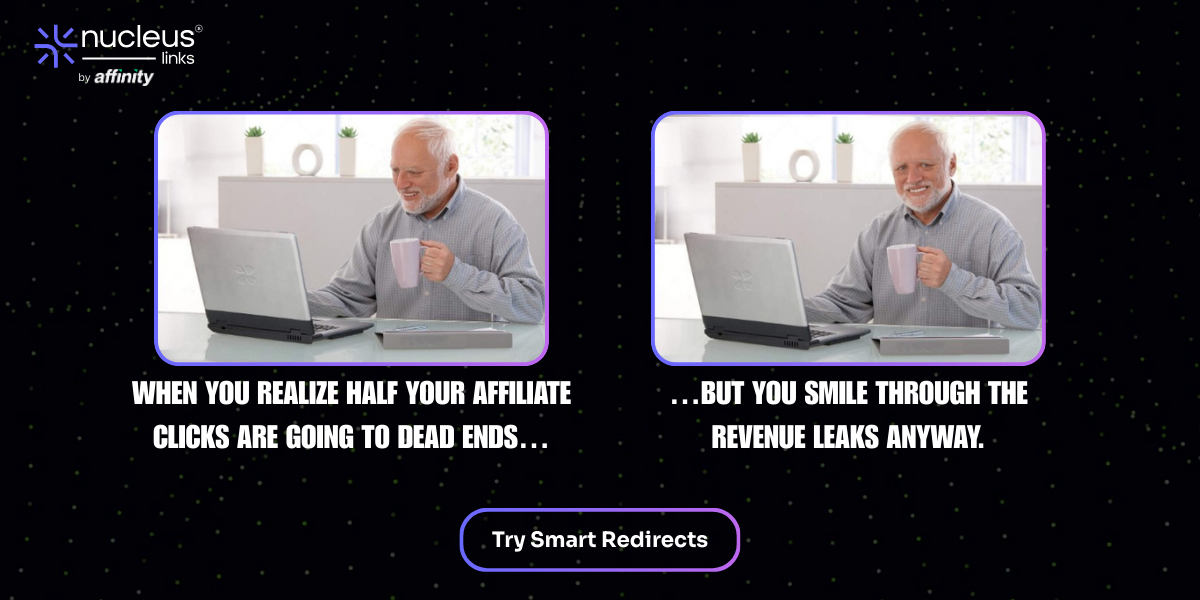Physical media
Exiting AI slop
The Rebooting’s latest research report, done in collaboration with Piano, found that 70% of publishers do not have a set framework for making tradeoffs when their business lines have conflicting goals. What’s more, 48% said their teams rely on their own success metrics rather than unifying around a single North Star. Download the report for more data on how publisher are approaching total monetization. Get the report

Hi, I’m Harold. I lose 50% of my affiliate revenues...

Step 1: Admit you have a dead link problem—it’s costing you more than you think.
Step 2: Stop grinning through the frustration. Broken links, bad redirects, and underperforming networks aren’t quirks, they’re leaks.
Step 3: Let Smart Redirects by NucleusLinks do the heavy lifting. It automatically reroutes every click to the best-paying network, plugging leaks, saving time, and boosting revenue by 30–120%. Start your 30-day Free Trial Today and see how quickly it pays for itself.
The revival of physical media
Everything comes back in style so there’s no wonder that both magazines are seeing a mini-revival, even if it’s in a smaller and far different role
Physical media is emerging as an alternative to digital media’s greatest weaknesses: it creates incentives to feed the algorithms with the regurgitation and micro dramas needed to win at Google Discover and in the fighting pits of feeds. The information space is likely to bifurcate between an AI-fueled algorithms serving slop 24/7 to brain-rotted zombies and a far smaller sector that consciously exits to create crafted products that run counter to synthetic media.
The so-called print revival is something of a misnomer. Print newspapers are not coming back. The Atlanta Journal Constitution pulled the plug on print after 157 years. The costs of print has kept rising. Daily news in a printed format does not make much sense.
Instead, the print revival is more around using print as a centerpiece for niche lifestyle brands. In this model, print acts as a signal to the audience of craft — and in opposition to the always-on churn-and-burn of digital media – and front for a business that makes most of its money in other ways that slinging ad pages.
This type of model works best in rich niches. I was taking a walk in Manhattan’s South Street Seaport last week and came upon a Racquet Club activation. Racquet is a magazine and newsletter brand focused on the lifestyle of tennis. It publishes a Kinfolk-like magazine and sporadic newsletters. The design is on point, and this kind of brand is optimized for activations. Publishing is necessary but insufficient — and far less important to the business than sponsor-heavy activations. Racquet lists “biannual collectible print editions” as one of several benefits, including “invites to iconic events” as part of its $100 annual subscription.
The magazine is one expression of the brand, more of a marketing artifact than a distribution vehicle. These brands remind me of the Monocle playbook. Monocle is an idiosyncratic brand that is easy to lampoon. It is also very considered in how its brand is expressed. And it has committed to print. Tyler Brule, Monocle’s founder, has made the simple point that many magazines stopped believing in print. They might have said otherwise, but after the financial crisis they largely gave up with cost cutting on paper stock and photography. Most mass market magazine brands are flimsy relics of a bygone era.
The economics of magazines are predictably different. That will not change in a more with less era. Vogue’s September issue was historically comically large, at one point nearly hitting 1,000 pages. This year’s is a more modest 365 pages. Vogue’s’ new “head of editorial content” Chloe Malle sounds sensible about magazines, not to mention the awkwardness of her job with Anna Wintour down the hall. Magazines will become like collectibles or built around cultural moments. That means they have to support other lines of the business like events and brand activations. The changing titles reflect the reality these jobs are more brand managers than editors in the classic sense.
Events are the other part of the pivot to physical media. With much of the economic value of media leaking, congregation remains a pivotal role. Semafor is now what Henry Blodget described Digiday: an events company with a website (and newsletters). There are undoubtedly too many events, particularly in business categories. But the hedge against the dystopian vision of AI is to build brands with the credibility to gather people together.
This week on People vs Algorithms, we will discuss the revival of physical media and more.
Google escapes. The remedies in Google’s search antitrust case were about as good as Sundar Pichai and Google shareholders could hope. This is the Microsoft browser case all over again. Antitrust actions tend to get overtaken by events in tech. This case began before ChatGPT burst in the scene. Judge Amit Mehta said it “changed the course of this case.” Terry Kawaja noted the verdict added to Google’s market cap the equivalent of all the major holding companies combined. I remember when Martin Sorrell would huff that WPP was Google’s largest customer and therefore had leverage. L-O-L.
The brewing AI culture war. JCrew is the latest brand to get exposed for using AI. The outpouring of negativity over the use of AI is an elite phenomenon. And it is self-interested, no doubt. I still believe AI has a brand problem and will face increasing populist backlash.
Another Vice morality play. Former Viceland creator Eddie Huang’s “Vice is Broke” tells the story of what might be the last large scale media folly. Looking back, my biggest takeaway is that money people are often very gullible because it was widely known in media circles that Vice was full of shit. It wasn’t exactly a secret. Media remains a great way to make a small fortune from a big fortune.
The Free Press gets off the spreadsheet. Dylan Byers reports Paramount will go ahead with a deal to buy The Free Press and install Bari Weiss in a prominent role at CBS News, which as Dylan notes will go over wonderfully after Paramount paid off Trump to get the merger approved. The valuation reported is comically wide — between $100 million and $200 million is a guesstimate — but will represent a BI-like multiple that indicates this isn’t about business fundamentals. Always good business to flatter the egos and ideologies of billionaires.
Plus: Anonymous Banker’s case in favor of the US Open’s $100 chicken nuggets and caviar box; the rise of padel as big business; media companies as talent managers; and media gets blamed for Trump is dead trending in the X fever swamp.
Send me a note with feedback by hitting reply.
For partnership information, see how we work with companies like Piano


